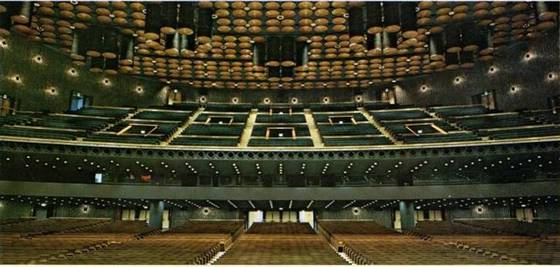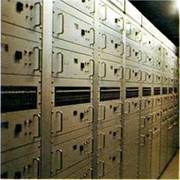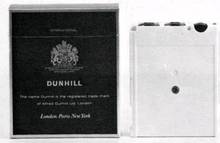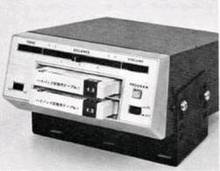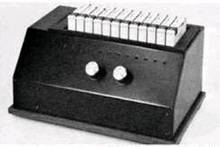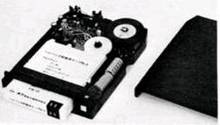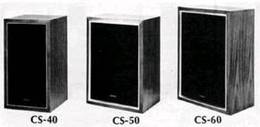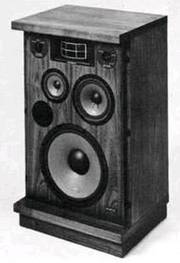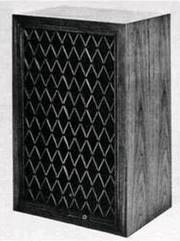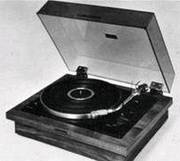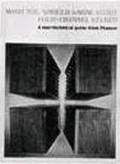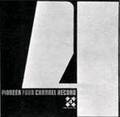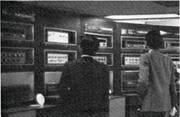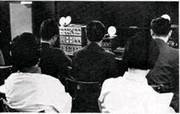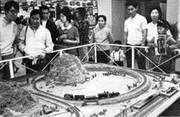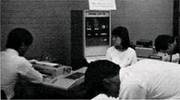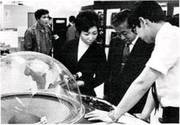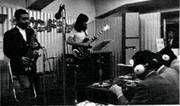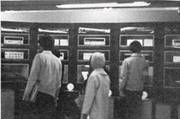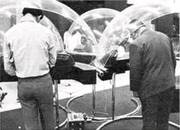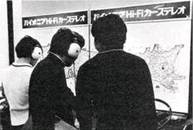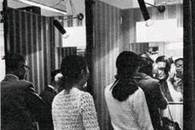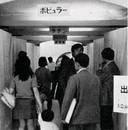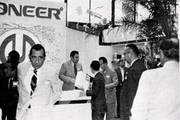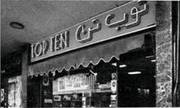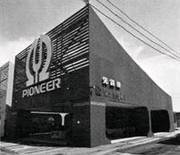Diese NEWs Bläter gab es vermutlich nur auf US Messen.
.
PIONEER SOUNDS IN ACTION - NEWS - VOL.3 NO.4 - 1971
In this issue of PIONEER NEWS, we present a relatively unknown aspect of Pioneer's corporate activities.
This is the Grand Hall of a religious organization. It is called the FUMON-KAN, and it is situated a few short miles from the heart of Tokyo. Covering an area of 10,300 square meters and having a seating capacity of 5.000 persons, it is the largest such structure in the Orient, comparable to any other major hall in the world, including the Crand Congress Hall of the Kremlin in Moscow.
The hall is equipped with a full range of the latest facilities.
These include:
- - Movable seating arrangements, whereby the seating arrangements for audiences can be changed depending upon the number in the audience. This is believed to be the first such system in the world.
- - Motion picture projection equipment, for all types of films ranging from 35 to 70 millimeters.
- - Screen process equipment.
- - Color TV projection equipment.
- - TV relay or filming equipment.
The hall is available for public use for lecture or seminar meetings, musical concerts, or motion pictures.
All the sound effects in the hall are handled by professional model Pioneer loudspeakers and control systems, each and every one a manifestation of Pioneer's outstanding audio technology.
A total of 58 model PAT-38X 3-way 15-inch coaxial loudspeakers are used as ceiling loudspeakers, wall loudspeakers, and gallery loudspeakers; an additional 380 loudspeakers are mounted strategically for reverberation effects, and oval loudspeakers are mounted in the rear of the seats at a rate of one for every four seats (for a total of some 1.200), to provide even and effortless dispersion of sound throughout the hall.
Controlling the operation of this array of loudspeakers is a system embodying the latest innovations and developments in audio technology, including variable reverberation time circuitry or individual level controls, for operation under optimum conditions at all times.
.
And driving the loudspeakers is a lineup of professional amplifiers designed and manufactured by Pioneer. A battery of 160 units power amplifiers' output is 6.000 watts. There are also background music equipment, wireless microphone equipment, and simultaneous interpreting equipment, to provide maximum versatility for all applications. Elsewhere in the building, there are many other unique Pioneer professional loudspeakers, such as column loudspeaker systems in the 4th floor Conference Hall or water-proof ceiling mounted loudspeakers in the restaurants or in the dining halls. Thus, the entire building is in effect a crystalizatibn of Pioneer's audio technology.
Professional sound systems manufactured by Pioneer are in operation in other well-known establishments throughout Japan, such as the theater-restaurant in the Imperial Hotel in Tokyo or the Imperial Theater in Tokyo, all active and working examples of Pioneer's farflung corporate activities.
.
PIONEER TAKES LEAD IN DEVELOPING NEW" HIPAC "TAPE SYSTEM
A new tape cartridge system called the "HIPAC" System, combining the features of conventional 8-track tape cartridges and cassette tapes, has been developed in Japan.
The Pioneer Electronic Corporation fulfilled a leading role in the development of the cartridge and accompanying recording/playback equipment, and also took the initiative in the formation of a consortium that is marketing the HIPAC System.
The consortium is comprised of ten major Japanese electronics manufacturers and record companies who are working together for further development and marketing of the system. The ten companies are:
- Apollon Music Industry Co., Ltd.,
- Clarion Shoji Co., Ltd.;
- Kodan-sba International, Ltd.;
- Sharp Corporation;
- Tokyo Shibaura Electric Co., Ltd.;
- Toshiba Musical Industries Co., Ltd.;
- Japan Columbia Co., Ltd,;
- Hitachi, Ltd.;
- Pioneer Flectronic Corporation; and
- Mitsui Equipment Sales Co., Ltd.
The need for the new cartridge was dictated by a number of factors. First and foremost, it was recognized by one and all that there was a tremendous growth potential in the packaged tape market in the seventies, a potential which predicted that packaged tapes could very easily assume a position superior to disc records.
- Anmerkung : Das ganze wurde für Pioneer (wie die Laserdisc auch) ein grandioser (finanzieller) Flop, weil der US-Markt (von Europa ganz zu schweigen) nicht mitzog und die 4-Kanal Kassetten-Tapes nie einen Durchbruch erlangten. Diese Dinger jaulten !!!
Weiterhin ist auch hier zu bemerken, man schmückte sich gerne mit einer größeren Anzahl von "Mitstreitern" - wie bei SONY mit der MD und der Elcaset und den DAT Recordern, die aber alle, wie wir im Nachhinein wissen, nur sehr zögerlich mitgemacht hatten. Das ganze Quadro- Abenteuer war in 1978 das teuerste Experiment von 3 konkurrierenden Gruppen von diesen sogenannten "Mitstreitern", die alle nur auf den Durchbruch der einen Entwicklerfirma gewartet hatten.
.
Es geht weiter im Promotion-Text
Interest - and demand for the new tape cartridges, which combine the merits of both conventional 8-track tape cartridges and cassettes, has steadily been mounting in the audio industry and among consumers. Highlighted among the merits is the endless operation capability of the new cartridge, similar to that of 8-track tape cartridges, and compact, handy size, the major feature of cassette tapes.
These problems indicated that a new tape cartridge, solving these inherent shortcomings, would serve as an impetus to the popularization and widespread use of packaged tapes in the future.
The new HIPAC tape cartridge embodies a number of features:
- * Small in size (at 72cc, less than a quarter of the 312cc. of conventional 8-track cartridges);
- * Unlike CC-cassette tapes, the HIPAC uses an "endless" tape for continuous, uninterrupted operation. This also facilitates operation on relatively simple drive mechanisms; provides trouble-free operation; and also lowers production costs;
- * Handling is simplified; there is no need to stop the machine and then turn the tape over; * v * Because of the small size of the cartridges, the size of the drive mechanism can also be reduced, a great advantage in designing stereo systems for motor cars;
- * Outstanding tonal quality;
- * 2-speed operation is possible (can be operated at either 4.8cm. per second or 9.5cm. per second on the same tape drive mechanism);
- * Wide range of applications -
- Home stereo sound systems
- Motor car stereo systems
- Recreational stereo equipment (such as portable stereo systems, or juke boxes)
- Business machines (background music systems, office dictating equipment, automatic announcing equipment, or automatic telephone answering equipment).
.
The development, production, and marketing of an entirely new tape system naturally involves a certain amount of risk. The consortium, fully aware of this very fundamental issue, has established a HIPAC Council, in which all ten member companies of the consortium are members, in order to work for the Cultivation and development of a market for the HIPAC System.
Meanwhile, the Pioneer Electronic Corporation is already working on the development of duplicating systems, to facilitate large-scale duplicating of pre-recorded tape cartridges.
.
HIPAC tape cartridges will be marketed by Toshiba Musical Industries Co., Lid., Japan Columbia Co., and Apollon Music Industry Co., Ltd., while the other member companies of the consortium, who are the electronic equipment manufacturers, will be marketing tape decks for home and motor car use, and also 8-track tape cartridge adaptors that will enable present owners of 8-track equipment to play back HIPAC cartridges on their existing equipment.
MAJOR SPECIFICATIONS OF THE "HIPAC" CARTRIDGE
Dimensions (width xdepth x thickness): 70mm x 85mm x 12mm
Weight: Approximately 50 grams
Tape width: 3.81mm
Tape winding : Endless winding
Tape speed: 4.6cm. per second or 9.5cm. per second
Number of tracks: 4
Number of programs: 2
Maximum playing time: 60 minutes (at 4.8cm. per second)
30 minutes (at 9.5cm. per second)
.
THE FUTURE OF PIONEER (wir sind am Jahresende 1971 !!)
In this issue of PIONEER NEWS we present excerpts from a recent speech given by Mr. Yozo Ishizuka, vice president of Pioneer Electronic Corporation.
The speech was made by Mr. Ishizuka on June 23 1971 at the Shoken Kaikan (Securities Hall) of the Tokyo Stock Exchange before a gathering of representatives from security companies in Japan.
Mr. Ishizuka's speech focussed on the future ahead for Pioneer. The speech began with an intermediate report of Pioneer's 25th business term from October 1970 to September 1971. In regard to the domestic sales of sound equipment except car stereo, Mr. Ishizuka emphasized the steady expansion of the company's market share which had resulted from an foresighted company production plan and the success of its sales policies.
.
Ein bemerkenswertes Wachstum ini 1971 - die Zahlen
Growth of stereo component sales was particularly remarkable during the period under review, he said, and the total sales of sound products had placed Pioneer at the top of ihe domestic market.
Sales are expected to reach a total of ¥22.5 billion (= "US$ 63 million" = 63 Milliarden Dollar) by the end of the term. On the export side, the total amount of exports of sound equipment except car stereo during the period is expected to reach some ¥17 billion (US$ 47 million = Milliarden Dollar) which is in excess of the figure projected at the beginning of the term.
Among the many reasons which have made this favorable prediction possible, Mr. Ishizuka said, are signs of a recovery in the U.S. economy and in general markets in the U.S. and Europe, a strengthening of the company's overseas sales network, and the decision by Sears, Roebuck Co., the largest mail order company in the United States to sell Pioneer products under the Pioneer brand name.
Car Stereo Department:
Mr. Ishizuka said that the car stereo market had shown a slump because of a slump in the automobile industry in America and a flood of medium and small sized manufacturers' products onto the domestic market with undercutting prices.
However, Pioneer has steadily developed its sales program from the long term point of view without becoming involved in a price-cutting war, and is now also undertaking rationalization of production with construction of the Kawagoe Works.
Four-channel car stereo systems and cassette car stereo systems with automatic reverse mechanism, recently introduced onto the market by Pioneer, have achieved a favorable market reputation and their sales are expected to reach a total of ¥7.2 to ¥7.3 billion (US$ 20 to $20.3 Milliarden) by the end of the current business term.
.
Speaker Division:
The recently established Pioneer Electronic (Taiwan) Corporation has been successful and began fully-fledged operation in June with a monthly production rate of one million units.
Judging from all the factors mentioned here, Mr. Ishizuka said that the company's total sales for the period is expected to reach some ¥ 52.5 billion (US$ 146 Milliarden) by the end of the term which represents a 15.6% increase over the same period for ihe previous year.
In regard to the fuiure projections for Pioneer, Mr. Ishizuka emphasized the need for the company to diversify its activities within the production category of sound equipment and related products.
.
HIPAC 4-track tape cartridge
The wide diversity in the field of car stereo equipment, audio and related products such as the HIPAC 4-track tape cartridge recently developed by Pioneer in conjunction with other Japanese companies, VTR equipment, and four-channel stereo, is expected to grow in the future.
Pioneer is making steady progress in research and development of products to meet with the expected future demand in these fields.
Mr. Ishizuka also said that Pioneer was continuing to make efforts to strengthen consumer-oriented marketing and Pioneer's own internal technological departments in order to develop new products which would have an unquestioned lead over their competitors.
And he said that Pioneer also was continuing to develop and strengthen its overseas sales network by reinforcing its capital and manpower.
.
EXECUTIVE PROFILES NO. 10: HIROSHI UENO
In this issue, we introduce Mr. Hiroshi Ueno, head of the Car Stereo Division and one of the four division chiefs of Pioneer.
Born in 1911 in Tokyo, Mr. Ueno is a true "Edokko" (child of Tokyo), having the "Edokko's" chief characteristics of warm generosity and sincerity. And despite his gray hair he retains much of his youthful vitality and is known in Pioneer for his vibrant personality.
Mr. Ueno is one of Japan's top-ranking engineers in the field of measurement equipment and he brought with him his precision skill when he joined Pioneer in 1966.
He now devotes himself to the manufacture of cartridge tape equipment such as 8-track car stereo and 8-track home units.
Mr. Ueno insists that the small mechanical parts of the car stereo are what really matter, and his department pays extremely close care and attention to them to ensure consistently high standards of quality. Like all perfectionists, nothing pleases him more than when the achievements of his division are recognized - such as the recent news from the United States that Sears. Roebuck and Co. have eliminated acceptance inspections for Pioneer's products.
Mr. Ueno is constantly stressing the reliability of Pioneer's car stereo products and advises dealers to sell quality first rather than compete in prices. He was a vigorous sportsman in his youth, but today only finds time for a little golf- and his favorite hobby of photography.
A NEW LINE-UP OF LOUDSPEAKERS - CS-40, CS-50, and CS-60
(eine Billig-Linie)
This is a new series of loudspeaker systems designed with one objective: to provide the highest standards of performance at their respective price levels. The CS-40 is a straightforward two-way system using a full size 10-inch woofer. Despite its amazingly low price, it provides smooth and flat reproduction of an extremely wide frequency range: 50 to 20,000 Hz. Its sensitivity -93dB/w - and its maximum input power rating - 30 watts - make it comparable to far costlier loudspeakers.
The CS-50 is a two-way system using a 12-inch woofer or truly superb, solid bass. Yet frequency speclrums handled by each of the two units are carefully selected so that the all-important mid-ranges are also reproduced smoothly and cleanly. With its input power rating of SO watts and its high sensitivity rating of 96.5 dB/w, it features outstanding "cost performance".
The top model of the series, the CS-60, is a true high fidelity loudspeaker system that provides smooth and clean reproduction over a 40 to 20,000 Hz frequency range, using a 12-inch woofer, a 5-inch mid-range unit, and a 3-inch tweeter. Both the CS-50 and the CS-60 feature a handsome walnut-oil-rubbed finish, and an attractive black grille netting. They are also provided with phone tape plugs to enable direct operation from tape recorders which generally have phone jack outlets for external loudspeakers. These and their other features, coupled with their extremely reasonable prices make these loudspeaker systems highly desirable models to fill a heretofore vacant area in loudspeaker lineups on the market.
.
CS-A770
In an era of compact, bookshelf tape loudspeaker systems. Pioneer has come forth with a full-sized floor type loudspeaker system for the most serious enthusiast, the CS-A770. It mounts in a solid, bass-reflex enclosure, four superb loudspeakers: a 12-inch woofer; 6-inch and 4-inch mid-range units (all of which are equipped with cones fabricated from Pioneer "F.B. (Free-Beating)" cone paper, a Pioneer exclusive and a multi-cellular horn tweeter, to provide a frequency range beginning at an ultra-low 30Hz and going all the way up to an ultra-sonic 20,000 Hz.
The long list of features includes click-stop level controls for precision adjustment of the mid-ranges and high-ranges; lerminals for use in conjunction with two-way or three-way multi-channel systems; and a detachable grille frame, making the CS-A770 a true masterpiece among floor type loudspeaker systems.
CS-99A
If the CS-A770 is the king of floor type loudspeaker systems, then the CS-99A is the king of compact, bookshelf type loudspeaker systems.
It is a superb five-way six-loudspeaker system equipped with a professional size 15-inch woofer, two cone-type mid-range units, a multi-cellular horn-type tweeter, and two dome-type super tweeters. Its frequency range starts from an ultra-low sub-sonic 25Hz and extends to an unbelievable 22,000Hz. It has a input power rating of a full 100 watts. Each of these features place it head and shoulders above the accepted definition of conventional bookshelf type loudspeaker systems.
The woofer and mid-range units use cones fabricated from Pioneer's superb "F.B. (Free-Beating9" cone paper, while a specially designed network is used in order to eliminate any of the distortion so often found in the vicinity of the crossover frequentcies of multi-way loudspeaker systems, to ensure smooth and flat response over the entire audio spectrum.
AND A TURNTABLE PL-A35
Placing the tonearm stylus in the groove of a record is a very delicate operation for, unless extreme caution is exercized, the record can very easily suffer irreparable damage in the form of scratches or damaged grooves.
Then there are people who may like to hear the same record over and over again, but don't want to be bothered with getting up and starting the record again. The Pioneer Model PL-A35 is a unique beltdriven turntable equipped with a fully automatic tonearm, that solves these problems at a stroke.
- Anmerkung : Das war völliger Unsin, das kam bei den Hifi-Fans absolut nie vor. Auch DUAL musste eine solch "repeat"- Funktion einbauen, weil es der Markt "angeblich" erforderte. Doch das stimmte nicht, allein die größere Anzahl an sogenannten "Features" war offensichtlich in den USA ein Verkaufsargument.
.
Operation
It operates in the following manner: first, the Selector is set to an appropriate position according to the diameter of the record to be played- 12-inch, 10-inch or 7-inch. Then simply setting the Lever to the START position activates the tonearm control system, lifting (he tonearm automatically from the tonearm rest, and gently lowering it onto the Starting groove of th* record to commence playback. And when the record comes to an end, the reverse happens: the tonearm rises from the record, and smoothly returns to the tonearm rest.
Additionally, if the lever is reset to the STOP position while a record is being played, the tonearm will lift from the record even if it has not been played out, and return to the armrest.
And setting the lever to the REPEAT position will provide repetitive playing of the same record without the listener having to go near the turntable.
All this means, in other words, that the operator never has to touch the tonearm, and so this eliminates any and all chances of mishandling or damage. Nonetheless, if desired, manual operation is still possible - setting the lever to the MANUAL position will enable manual operation using the arm elevation mechanism.
The automatic tonearm mechanism uses its own servo geared motor, for complete freedom from malfunctions or adverse effects upon the turntable as are so often observed in mechanically-activated automatic turntables, so in effect the PL-A35 is a "two-motor" turntable.
The PL-A35 possesses still other features: an anti-skating device (das wiederum war ein feature, das von DUAL mit dem 1019 in den Markt gedrückt wurde), a free stop hinge-dust cover, a stylus pressure direct-reading type tonearm that allows changing of cartridges, etc., all combining to endow the turntable with every feature desired by the most serious audio enthusiast.
.
SALES AIDS
LAYMAN'S BOOKLET ON 4 CHANNEL STEREO
Everyone today is talking about four-channel stereo systems - the latest advance in modern hi-fi stereophonic technology.
Now everyone can read about it too ... in a special 18-page pamphlet prepared especially for consumers by the Pioneer Electronic Corporation. Entitled "What You Should Know About Four-Channel Stereo - A Non-Technical Guide From Pioneer" the booklet does what is says, and explains for the layman, in a clear, concise way, exactly how the system works.
4-CHANNEL STEREO DEMONSTRATION RECORD
Pioneer has put together a new demonstration record, the PQX-1002, designed to enable the general public to understand and appreciate the effects of the Pioneer Quadralizer.
Side One contains a series of tunes plus commentary recorded in order to give full play to the respective merits of the Matrix System and the Phase Shift System, while Side Two contains sound effects recorded "live" and tunes that are designed to enable the listener to choose between Matrix and Phase-Shift operation in playback, to discover for himself the type of operation he prefers.
Impressive - The PIONEER SOUND SHOW
Something new in sound was brought - to thousands of fascinated Japanese recently when Pioneer's Sound Show visited department stores throughout the country.
The Show was called "Sound To See, Sound To Hear and Sound To Touch" - and with a name like that, it was full of new ideas. "Situation Theater Of Sound" was the name of one of the displays which featured a model train layout complete with sound effects of a train running through a pastoral setting ... roaring sounds as the train passed over a railway bridge, voices of station announcements when the train pulled into a platform, etc.
An elaborate electrical relay system was used to reproduce the sounds using over 10 8-track professional cartridge player units.
The Sound Map, another of the displays, was a popular exhibit with all age groups. A steering wheel and an accelerator enabled the visitor to "drive" all over a large map of Japan placed on the wall in front of him.
A moving light roamed over the map as the "driver" accelerated and turned the steering wheel.
And while he travelled up and down Japan, he could hear folk songs from various parts of the country through special headphones.
For those who wanted their fortunes told, there was the musical dice game. Dice were placed on top of a huge 63cm diameter woofer, which, when switched on, set the dice dancing over the speaker to the vibrations of the heavy bass sounds. The person's fortune was read from the numbers shown on the dice when the sounds stopped.
If you were not satisfied with the reading of your future from the dice, there was the magic mirror, where your fortune was told by a famous physiognomist through special headphones.
Young people especially were interested in the telephone answering machine corner where a famous film star gave personal messages when the user dialed a set number.
And finally, for the homemaker, there was a computer which was programmed to assemble the most suitable stereo system for visitors who had filled out data sheets with information about their homes and preferences in hi-fi.
Besides all this, the Show also included a special audition room for four-channel stereo and a stage for daily performances by well-known popular singers. Radio programs compered by leading disc jockeys were recorded or relayed from many of the Sound Show display centers throughout Japan.
And of course on display at every Show was a full range of Pioneer's latest products, highlighted by the company's four-channel stereo systems.
.
TOPICS HERE THERE AND EVERYWHERE
NEWS FROM THE UNITED STATES
Although the electronic show held in Chicago from June 27 to June 30 1971 was correctly titled the "All American Consumer Electronic Show", it was one in which Japanese manufacturers played a dominant role.
And in the forefront was Pioneer Electronic Corporation, whose modern blue and white booth received great attention from the visiting dealers from all over the U.S.
In the past, the Show, held at McCormick Place, was highlighted by displays of the latest color television sets. But this year, the main products were in the audio line and the enthusiasm for them by Americans was quite obvious. At the Pioneer booth, the design of the "E"-Series speakers, the new light-weight headphones, and Pioneer's four-channel stereo equipment received special attention from visitors.
The demand from consumers for audio components has increased recently in the U.S., and at the same time Pioneer's reputation for high quality products has risen even higher.
As a result, business inquiries, as well as actual transactions for orders, showed a satisfying increase during the period of the Show. Because of Pioneer's participation in the CES this year, the future expansion of the company's activities in the American market now seems assured.
.
NEWS FROM LEBANON
Les Fils de Georges Haddad & Co., Pioneer's sales agent in Lebanon, recently opened a show room in Beirut. The show room, the first of its kind in the city, is filled with attractive displays ol Pioneer products.
1971 SINGAPORE TRADE EXHIBITION
Hwee Seng and Company, Pioneer agents in Singapore, attracted record crowds to their pavilion at the recent Singapore Trade Exhibition.
And no wonder, when you look at the photograph. One of the most modernistic at the exhibition, the Pioneer pavilion was a firm favorite with the visitors.
Hwee Seng exhibited a wide selection of Pioneer's products at the May Fair, including four-channel stereo. The technical achievements of more than 250 international companies were on display at the Exhibition held in Kallang Park and visited by more than half a million Singaporeans.
.


